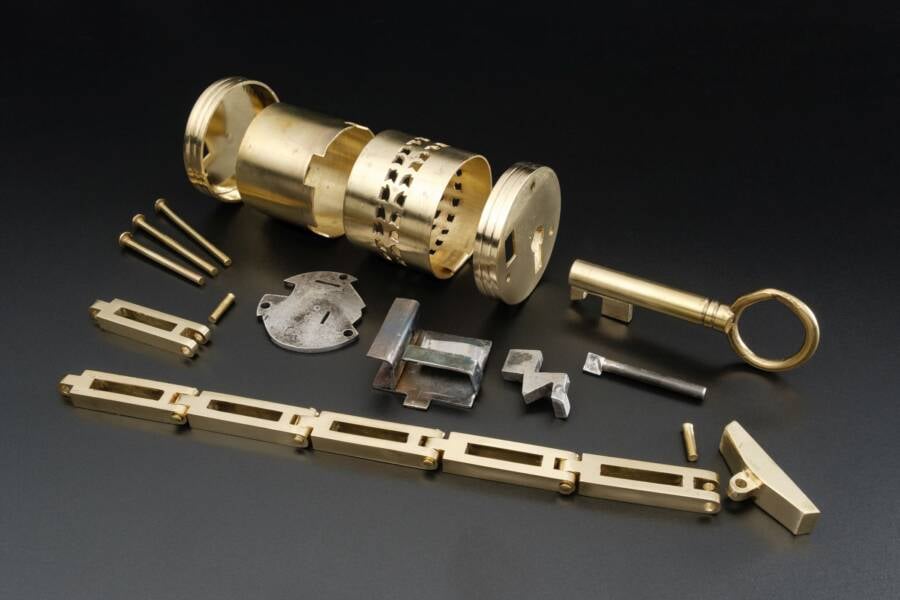“Lost for Centuries: A Metal Detectorist Unearths a Stunning Golden Roman Lock That Could Rewrite History!”
Imagine stumbling upon a piece of ancient history during a metal detecting stroll—sounds like an Indiana Jones flick, doesn’t it? Well, grab your fedora for a moment, because in 2023, metal detectorist Constantin Fried unearthed an extraordinary tiny treasure, a gold miniature Roman lock measuring just over a centimeter across! This gilded gem dates back to the third or fourth century C.E. and is said to be “probably unique in Europe.” Discovered in a field in North Rhine-Westphalia, Germany, it raises curious questions about its journey through time. What secrets did it safeguard, and how did it end up in this specific spot? The craftsmanship of such a tiny item is astounding and suggests a connection to the larger narrative of Roman culture in far-flung places like Westphalia. Buckle up as we dive deeper into this fascinating find! LEARN MORE
Made of lustrous gold and measuring in at just over one centimeter across, this lock was likely made during the third or fourth century C.E.

LWL/S. Brent guideThe miniature Roman lock made of gold found in Germany measures just 0.47 inches in diameter and 0.43 inches in height.
The Westphalia-Lippe Regional Association (LWL) recently announced the discovery of a miniature Roman lock, smaller than a dime, that was unearthed in North Rhine-Westphalia, Germany in 2023. The lock was discovered during a metal detecting survey in a field near Petershagen-Frille and was subsequently reported to the LWL, where it was examined by archaeologists.
Researchers determined that the box lock dated back to the third or fourth century C.E. and that the discovery is “probably unique in Europe according to current research,” per a translated statement from LWL director Dr. Georg Lunemann, who added, “I am thrilled that we can come up with such high-quality finds here in Westphalia.”
The Discovery Of An Ancient Roman Lock In Germany
In 2023, licensed metal detectorist Constantin Fried was surveying a field in Petershagen-Frille when he came across a surprising discovery. Right there, just below the dirt in the field, was a minuscule lock made of gold, one that presumably would have been used to secure a box containing valuables. The artifact’s shape was familiar to him, but the size certainly was not.
“I could hardly believe it myself when I held the find in my hand,” Fried said. “Because such Roman locks are usually much larger and consist of iron or bronze parts.”

Constantin Fried/LWLThe Roman lock as it was found in Petershagen-Frille, Germany.
Experts from the LWL confirmed this initial assessment, noting similarities between its construction and the manufacture of larger box locks from the Roman era. “The lock was certainly made in the provincial Roman area and can be dated to the 3rd or 4th century AD based on its shape, technical structure and style of decoration,” said LWL cultural director and archaeologist Dr. Barbara Rüschoff-Parzinger.
There are numerous ways in which the small lock could have found its way to Westphalia. LWL Archaeology director Dr. Michael Rind suggested that a local elite or soldier may have brought back a small chest affixed with the lock upon returning from military service. In any case, Rind noted that the find was exceptionally rare.

E. de Bourdeaux/LWLLicensed metal detectorist Constantin Fried, the man who made the discovery.
“The golden miniature tin lock is the only one of its kind in Europe and is the northernmost tin lock found in Germany,” he said. “Was it a one-off creation or have similar precious miniatures simply not been found before? We will continue to work on these and other questions.”
Researchers Analyze The Miniature Roman Lock And Create A Larger Replica
Once researchers had the lock in hand, they were able to conduct a more thorough analysis of its construction. While the key and chain were missing, they did observe that the lock itself was comprised of two cylindrical metal sheets closed with lids on top and at the bottom, secured with three rivets. Restorers also observed a rusty iron core and a broken bit of the end of a chain link, calling into question whether the lock had once had a functioning mechanism.

Paul Scherrer Institute/Villigen [CH]/ David MannesCT imagery of the Roman lock.
To answer this question, they used a “3D neutron computed tomography” (CT), a technique rarely used in archaeological examinations. However, in this instance, it was necessary, as according to Rind, “Even a 3D X-ray computer tomography scan could only show the rivets, which are also made of gold, and the chain end link inside due to the high density of the gold lock casing.” The researchers needed to see how the lock worked on the inside, though.
Thankfully, the CT examination made this possible. The high-resolution image quality allowed the team to learn how the lock worked, revealing cross-sections of a frame with a spring, guide rail, bolt, base plate, and a pin. In other words, it did indeed function.

LWL/Stefan BrentführerThe replica Roman lock, four times the size of the original.
“They also showed that the mechanism is largely complete but damaged, because someone had obviously poked around in the lock at the time, probably to break it open or to remove a blockage,” said Fried.

















